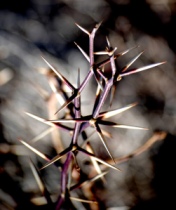I thought I had killed it. Totally ruined. Destroyed.
I had well completed a myriad of tasks during the many, many childhood summers spent in southeastern Arizona with my grandparents and the twenty acres of desert land they cared for. We had dug ditches, run irrigation, kept the field grasses short (so snakes would be kept at bay), cared for animals of varying types, tore old buildings down, painted the ones still standing, and trimmed a lot of mesquite trees.
 Have you ever trimmed a mesquite tree? For those of you who haven’t, a brief word of explanation: Mesquite trees aren’t really ‘trees’ at all, they’re bushes. In order to make them look like trees, they need constant attention. They are thorny… really thorny—huge, long, deep-penetrating thorns (see inset)—and gnarly. After years of practice, though, I felt I had become a master mesquite tree trimmer.
Have you ever trimmed a mesquite tree? For those of you who haven’t, a brief word of explanation: Mesquite trees aren’t really ‘trees’ at all, they’re bushes. In order to make them look like trees, they need constant attention. They are thorny… really thorny—huge, long, deep-penetrating thorns (see inset)—and gnarly. After years of practice, though, I felt I had become a master mesquite tree trimmer.
On this particular day, the one tree I had to get done was the lone mesquite in the small back yard my grandparents had fenced off from the rest of their land. Every “unnecessary” limb, twig, shoot, and leaf was calculatingly severed. I was in a tree-trimming trance. Up close, I could see every part that “needed” cutting; an extra little bit here, a corrective measure there. When I finally stepped back, I was in shock—where there used to be a full-looking arboreal treasure now stood a stark, naked shuck of sticks protruding out of the ground. I really thought I had killed the tree. Worse yet: there was no hiding the carnage—the kitchen window looked right out onto that place where once had stood a thing of rugged beauty.
My Gram surprised me with her grace and understanding. She told me not to worry—that by so radically cutting back a mesquite, it was given opportunity to re-form and come back more beautiful than before.
Yeah.
Right.
Each day for the rest of that summer, I would look at the tree as I passed by… and I couldn’t see any evidence of life or hope for the poor thing.
Well, Grandmas are usually right and this time wasn’t an exception. The potential of the mesquite isn’t in what you can see—the tallest they get is around 30 feet high. Their strength is in their roots, which dig deep: some say around 175 feet for an older tree. Over the next few years, this particular tree rebounded. Not as quickly as it took me to ‘destroy’ her, but she came back fuller, greener, more vibrant than all but one other mesquite in the place.
The other beautiful tree?
One my uncle had “killed” years before I was conceived.
This has me thinking about some of the hardship we experience in life. Aspects of who we are or what we do—our churches, our families, our relationships—that simply seem dead. What we can see looks nothing like what we think should exist; parts of us have been cut back and to have hope is a ridiculous notion. Sometimes we’re to blame for what has happened, just like me with that thorny tree. But often we can see the hand of a loving God calling forth life; and where hope was seemingly exterminated, something vibrant comes.
The re-birth takes time… it’s not as fast as the destruction, but rebuilding and replanting never takes place as quickly as uprooting and tearing down. Look beyond what is missing and see if there, where you least expect it, God is at work doing a new thing.
What is ‘dead’ in your life right now? What have you endured, maybe even as the result of your own hand at work, that seems too painful and needless to be of any good? Are you firmly rooted in the soil of God’s love and faith in his Son? If so, especially in this Resurrection season, we must be looking for the signs of life—after all, ours is the King who offers abundant life and conquers death. He is the God who gives life to the dead and calls into being things that were not (Romans 4:17, TNIV).



